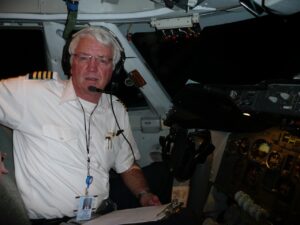In honor of Military Month, we are profiling employees who have either served or are currently serving in the military. This week, we meet Air Force veteran Richard Cline (known to many at Atlas as RC Cline). RC joined Atlas in June of 1998 as a First Officer and officially retired in 2015 after flying the 747 for his entire tenure. He continues to support Atlas today from behind the flight line, in Human Resources, where his work has a lasting impact, long after his final landing as a pilot.

Captain Cline in the flight deck of a 747.
What inspired you to get involved in aviation?
I have always been absolutely enthralled with airplanes. I grew up in a military family, and we went to every air show we could. I asked every pilot how they got to their position, and I asked thousands of questions about every single airplane I saw. I was especially fascinated by military aircraft and dreamed about flying one someday.
Tell us about your journey to become a pilot.
Following my high school graduation, I enlisted in the Air Force and went to technical school for computer programming. (This was back in the day when we used punch cards and dot-matrix printers!)
The Air Force only chose pilots who were commissioned officers, and that required a college degree. I heard of another pathway to the Air Force Academy for enlisted members, through the United States Air Force Academy (USAFA) Prep School. I applied, was accepted, and earned an appointment a year later. I graduated in 1974.
From that point on, my Air Force flying career took off. This included undergraduate Pilot Training in Texas and Lead in Fighter Training (LIFT) in the AT-38 in New Mexico. These trainings enabled my dream to become my reality — flying fighters.

Captain Cline during his days with the Air Force.
I started with F-4’s at Luke Air Force Base in Arizona, then F-5’s in Las Vegas and the Philippines, AT-38’s in New Mexico and finally F-15’s in Bitburg Germany and Alaska. I retired from the Air Force in 1993 and traveled to Bahrain as an F-5 instructor with the Bahrain Amiri Air Force.
How did you find Atlas?
My brother’s neighbor in Alaska worked at Atlas and shared his positive experience with me. I applied and interviewed with Grant Kaschiske (retired Captain Kasischke now works on the Support Flight Ops team in the Chief Pilot’s office). While I was waiting to hear back from Atlas, I was offered a 747 First Officer’s position with Polar. I went through Polar’s “Indoc” (indoctrination training) and started ground school and simulator training. Before long, Atlas called and offered me a First Officer position on the 747, so I jumped at the opportunity.
I was based in Alaska and spent my entire career on the B-747 fleet. At the time, the fleet was comprised of the B-747-200 and -300 (Classic) aircraft. After 10 years on the Classic, I transferred to the -400 and was fortunate enough to even fly the -8 before retiring in 2015.
I was a Ground School Instructor on the Classic, helped the Training Department develop the Atlas Winter Operations/De-Icing training program and developed an Atlas North Pacific Emergency Airport Chart. With a home base of Alaska, there was an abundance of weather conditions and expertise from the aviation community to draw upon.
What is your most memorable moment since becoming a pilot?
I have so many! My Atlas career spanned 17 years, taking me to exotic cities all over the world. I have many great memories of excellent crews, top-notch support people and fantastic cooperation from the entire Atlas family to get the job done in a variety of challenging conditions.
My most cherished memories of my times at Atlas were in the air: climbing through the clouds to break out and see towering thunderstorms in Southeast Asia, moving the U.S. military men, women and equipment all over the world, flying over 100 tons of chocolate from San Francisco to Hawaii and moving Picasso’s priceless “Night Fishing at Antibes” from Sydney back to the New York Metropolitan Museum.
What made you want to come back after retirement?
I retired from flying in 2015. Almost three years ago, I received a phone call from Grant, asking if I would be interested in conducting online Pilot interviews.
It has been a very rewarding three years meeting the great people in our HR department and seeing the passion of hundreds of Atlas applicants. I am very proud of the job our team has done — adding well over a thousand pilots to the Atlas family!